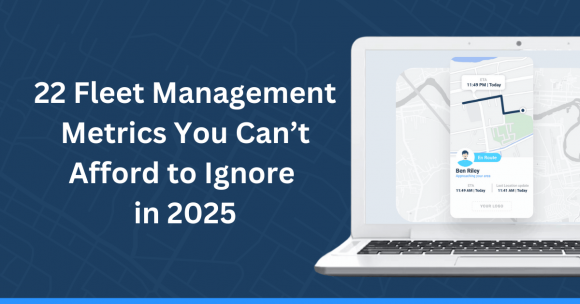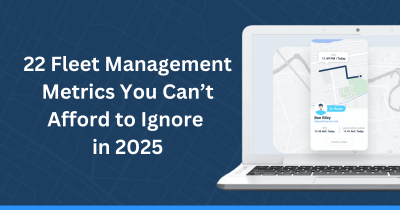Fleet management is no small task. From monitoring vehicle performance to ensuring deliveries run smoothly, keeping everything under control means having the right data at your fingertips.
In short, metrics are the backbone of smart fleet management.
They help identify inefficiencies, reduce costs, and improve overall operations. Without tracking these, you’re essentially flying blind.
In this guide, we’ll dive into 22 critical metrics every fleet manager should monitor in 2025.
These metrics are divided into categories like cost efficiency, driver performance, vehicle health, and customer satisfaction, making it easier to focus on what matters most.
Let’s dive in!
Why You Need Fleet Management Metrics
Effective fleet management hinges on real-time data.
A 2023 report from McKinsey highlighted that businesses using data-driven fleet strategies saw a 20% increase in operational efficiency.
Metrics not only offer insights but also help identify trends, spot potential problems, and ensure your fleet is always at its best.
Cost Efficiency Metrics
Cost efficiency is without a doubt the cornerstone of fleet management.
Managing costs effectively means finding ways to boost your operations without sacrificing quality.
In short, these metrics will help you identify where your money is going!
1. Fuel Consumption
Fuel is one of the biggest expenses for fleet operations. Tracking fuel usage helps identify inefficient vehicles and routes.
Tools like GPS tracking and route optimization software can cut fuel costs significantly.
2. Maintenance Costs
Unexpected repairs can wreck your budget. Monitoring maintenance spend helps you decide whether to repair or replace vehicles.
3. Cost Per Mile
This metric combines fuel, maintenance, and operational costs to show the true expense of running your fleet.
Lowering this figure means boosting profitability.
4. Total Cost of Ownership (TCO)
TCO accounts for purchase prices, fuel, repairs, and depreciation. It’s vital for making smarter investment decisions about your fleet.
Driver Performance Metrics
Your drivers are vital to the success of your business. Thus, monitoring the fleet’s performance ensures their safety, as well as higher productivity and customer satisfaction levels.
It also gives you an overview of possible improvements, such as assigning drivers to new routes or minimizing downtime between deliveries.
5. Driver Safety Score
Monitoring speeding, harsh braking, and cornering can help reduce accidents.
Use telematics to track these behaviors and implement driver training programs when needed.
6. Idle Time
Excessive idling wastes fuel and damages engines.
Keeping this in check can save money and extend vehicle lifespan.
7. Deliveries Per Driver
This metric measures how productive your drivers are.
It helps you identify high-performing employees and those who may need additional training.
Vehicle Health Metrics
The health of your vehicles also impacts operational efficiency and safety.
Keeping a close eye on these metrics can help prevent costly breakdowns and extend the lifespan of your fleet.
8. Vehicle Downtime
Every minute a vehicle is off the road costs money.
Tracking downtime helps plan better maintenance schedules to keep your fleet operational.
9. Average Vehicle Age
Older vehicles often require more repairs.
Monitoring fleet age ensures you retire aging vehicles before they become a financial drain.
10. Tire Wear and Pressure
Under-inflated tires increase fuel consumption and the risk of accidents.
Regularly tracking tire health improves both safety and efficiency.
Operational Efficiency Metrics
Operational efficiency is about making the best use of your fleet’s resources – from calculating the best delivery times, to knowing which vehicles are in use.
These metrics ensure that vehicles, routes, and schedules are optimized for maximum productivity and minimal waste.
11. Route Efficiency
Tracking which routes are the most fuel-efficient helps optimize deliveries and reduce costs.
12. Delivery Times
Are your deliveries on schedule?
Monitoring this ensures better customer satisfaction and identifies potential bottlenecks.
13. Asset Utilization
How often are your vehicles in use?
High utilization means your fleet is productive, while underused assets could be costing you money.
Compliance and Risk Metrics
Staying compliant with regulations and minimizing risks are non-negotiable for fleet managers!
These metrics help you track adherence to legal requirements while reducing liability and ensuring safety.
14. Hours of Service (HOS) Compliance
Ensure drivers stick to regulated hours to avoid fines and keep everyone safe.
15. Accident Rates
Monitoring accidents per mile helps assess risk and improve safety protocols.
16. Insurance Claims
Frequent claims indicate underlying problems, such as poor driver behavior or vehicle maintenance issues.
Customer Satisfaction Metrics
At the end of the day, your fleet’s success depends on happy customers. This is just a simple, hard truth.
These metrics below focus on reliability, communication, and service quality to ensure you meet (or even exceed!) customer expectations.
17. On-Time Delivery Rate
Timeliness is crucial for keeping customers happy.
Tracking this metric ensures you meet or exceed expectations.
18. Customer Feedback
Post-delivery surveys provide valuable insights into your service quality and areas for improvement.
Environmental Metrics
Sustainability is a big priority across industries, and so tracking environmental metrics is also a critical factor.
These metrics help fleet managers reduce their carbon footprint and adopt greener practices, which are both cost-effective and eco-friendly.
19. Carbon Emissions
Tracking emissions is increasingly important for businesses looking to reduce their environmental footprint.
Use this data to identify ways to go greener, like switching to electric vehicles.
20. Fuel Type Usage
Monitor how much of your fleet relies on diesel, gas, or alternative fuels.
This data can inform future investment in sustainable options.
Financial Performance Metrics
Your fleet’s financial health determines its long-term viability.
These metrics below provide insights into profitability and help you justify investments in vehicles, technology, and operations.
21. Return on Investment (ROI)
How much value are you getting from your fleet?
ROI calculations help justify expenses like new technology or vehicle upgrades.
22. Revenue Per Vehicle
Track how much revenue each vehicle contributes to ensure your fleet is pulling its weight.
Final Takeaways on Fleet Management Metrics
At the end of the day, metrics are more than just numbers. It’s a window into the health, efficiency, and profitability of your fleet.
By tracking these 22 essential metrics, you can make smarter decisions, improve operations, and stay competitive in a demanding industry.
NOW READ: 12 Game-changing fleet management benefits for small businesses
About the author
Cheryl has contributed to various international publications, with a fervor for data and technology. She explores the intersection of emerging tech trends with logistics, focusing on how digital innovations are reshaping industries on a global scale. When she's not dissecting the latest developments in AI-driven innovation and digital solutions, Cheryl can be found gaming, kickboxing, or navigating the novel niches of consumer gadgetry.










